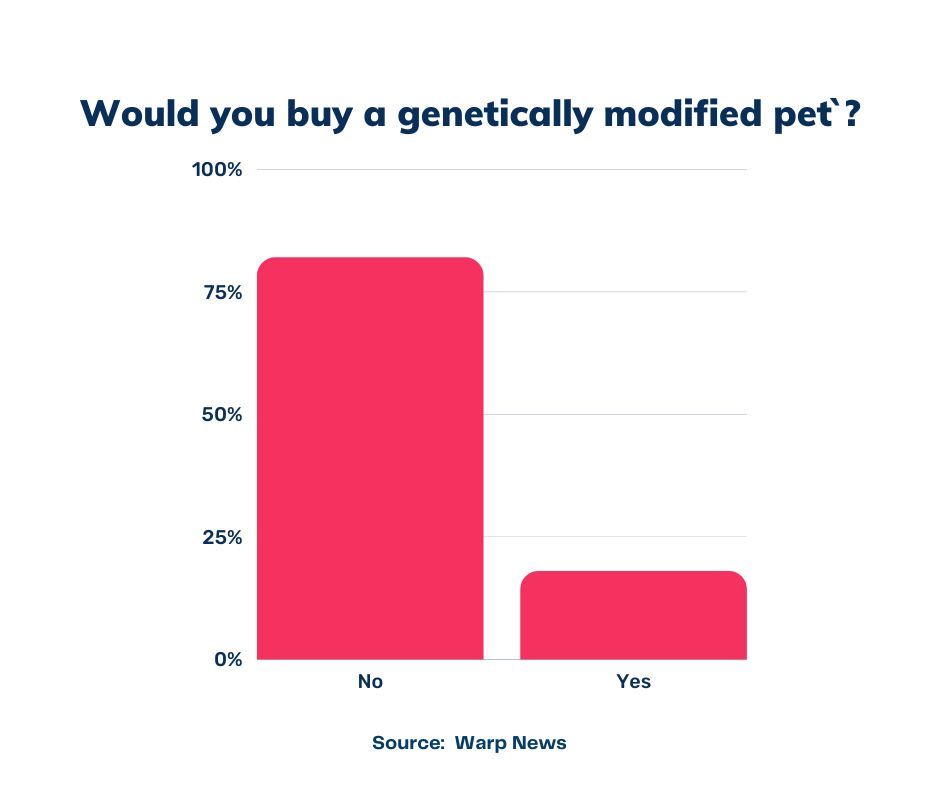
💡 Optimist's Edge: Do you want a gene-edited pet?
Would you buy a genetically modified pet? Maybe a luminous cat who can not get sick with AIDS? Or why not a pet that does not cause allergies? Or dogs that can not get muscular dystrophy?
Share this story!
📉 What people think
Say “gene editing” or “genetic modification” and many people become concerned. It "feels" unnatural. This is also reflected in Warp News' survey when we ask the question "Would you buy a genetically modified pet?".

Over 82 percent answered that they would not buy a genetically modified pet.
It may come as a surprise to them that there is actually hardly anything else to buy.
📈 Here are the facts
Genetically altered pets are nothing new. Remains of the so-called Bonn-Oberkassel dog, which was found buried next to humans, are 14,200 years old. Cats were domesticated in the Middle East around 7500 BC. Humans have had pets for a very long time. During this period, we have created a huge genetic variation, from pugs to Persian cats. Today they have very little in common with their ancestors.
Humans have thus been editing genes for a long time. Almost all pets that exist today are genetically modified in one way or another to suit us. The big difference now, with technology like CRISPR, is that it goes much faster and is much more powerful.
CRISPR, popularly called the gene scissors, is a gene-editing tool that enables very precise changes in the genome. With this tool, it is possible to deactivate or replace genes or correct individual letters in the genetic code very precisely, much like when we change misspellings in Microsoft Word. This opens up opportunities for treating or curing serious genetic diseases, even in our pets.
But the technology can also be used to give pets new capacities...
💡 Optimist's Edge
Modern gene editing tools now make it possible to give, or remove, certain properties in living organisms.
💡 Allergy-free and super pets will soon become a reality - thanks to gene-editing technology.
While editing human genes is a sensitive territory with cautious progress, things are moving faster for animals. With modern genetic engineering, we can produce:
- Allergy-free cats. U.S. researchers have found an effective way to block the most common source of cat allergies using CRISPR. In an article published in The CRISPR Journal in April 2022, they explain how it works.
- Dogs without muscular dystrophy. In a study published in the journal Science, researchers at UT Southwestern Medical Center describe how they successfully treated the genetic defect that is the cause of Duchenne muscular dystrophy in four beagle dogs. Good for dogs, but also an important step closer to CRISPR treatment also for people with the disease.
- Twice as strong dogs. Chinese researchers have created dogs that are twice as strong as they would be without genetic treatment. The process used can help avoid human diseases, say the researchers who published the study in the Journal of Molecular Cell Biology.
- Luminous cats without AIDS. As early as 2011, researchers succeeded in introducing genes into cats that helped them resist the malignant form of AIDS. They also succeeded in introducing a gene that produces a fluorescent protein called GFP. The protein, which is found naturally in jellyfish, is often used in this field of research to monitor the activity of edited genes. The cats that could resist AIDS thus became luminescent. The study is published in Nature Methods.
👇 How to get the Optimist's Edge
Research in this area is still young. There are undoubtedly spectacular examples and more are to come.
❓ So how do you get the benefit of this knowledge?
- Allergy sufferers - be patient. Fur allergy is common and a big reason why many do not get pets. However, this may change faster than you think. Genetically modified and allergy-free pets are finally on the horizon.
- Animals first, humans later. A large part of genetic research begins with animals. They are the predators who show what we can expect in the form of treatments for humans as well. Keep an eye on this research and you will look into the future.
- The genre revolution. The CRISPR genetic scissors have revolutionized genetic engineering in a short time. Huge breakthroughs await and more researchers, more knowledge, and money are needed. This is a hot area to go into.
- Unnatural. Many people are reflexively afraid of genetic engineering. The area must be approached with care, but the possibilities are much greater than the risks. More people need to be informed objectively that basically everything we eat and most of the animals we have close to us are genetically modified - it has only happened over a long period of time. On the contrary, genre editing is natural for us humans. With new powerful gene tools, we can reduce suffering and create better lives for both humans and animals.
- Test CRISPR yourself. If you live in the USA, you can order a CRISPR kit at home and experiment with the technology yourself. An example of many is The Odins DIY Bacterial Gene Engineering CRISPR Kit for $169.
You now have an advantage because you have gained this knowledge before most others.
Do you want more? Discuss with others in our forum!
Share your ideas and thoughts with other Premium Supporters in our Facebook group. Maybe you will find a prospective business partner or investor.
By becoming a premium supporter, you help in the creation and sharing of fact-based optimistic news all over the world.


